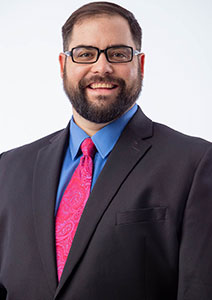And while many people globally and across the United States—regardless of their gender identity—are experiencing pandemic anxiety at some level, those who identify as SGM appear to have been disproportionally affected by the pandemic both physically and mentally.
Those are among the findings by Scott Emory Moore, an assistant professor at the Frances Payne Bolton School of Nursing at Case Western Reserve University, and research partner Kelly Wierenga, an assistant professor at the Indiana University School of Nursing.
Their work was recently published in the Journal of Homosexuality, which had put out a call for COVID-19-related research. Three others contributed to the work: Dana Prince, an assistant professor at the Jack, Joseph and Morton Mandel School of Applied Social Sciences at Case Western Reserve; Laura Janine Mintz, MD, a doctor in internal medicine/pediatrics at MetroHealth Medical System; and Braveheart Gillani, a graduate student at the Mandel school.
“The reason we thought this was important enough to study in the very beginning was that this isolation being foisted upon people would function as a prevention mechanism—that it could prevent SGM adults from addressing existing and well documented mental health differences they experience,” Moore said. “And the study shows that those differences were exacerbated during the first three months of the pandemic.
“This paper basically codifies what a lot of people in sex-gender minority community have been feeling.”
The researchers also found that SGM respondents experienced:
- More frequent COVID-19-associated physical symptoms and depression and anxiety symptoms.
- A significantly higher proportion of depression and anxiety scores exceeding the threshold for what would be of clinical concern, “indicating that the person qualifies for further assessment for depression and/or anxiety”
Moore and Wierenga conducted an online survey of 1,380 adults in the United States—290 who identified as SGM and 1,090 who did not (cisgender heterosexual)—from March 23 to June 20, 2020.
They asked participants about perceived social support and about both physical and psychological symptoms. They also asked about participants’ “ruminating,” or continuously thinking the same thoughts, usually sad or dark, which may lead to poorer mental health outcomes.
“What we want to draw attention to is that the life-saving measures of social-distancing may have a real and lasting impact on interactions between people and may affect mental health,” Wierenga said.
Many SGM adults may have already experienced isolation from their families, particularly their biological parents, Moore said.
“Many SGM people will refer to ‘family of choice,’ meaning that they get their needed support from a variety of people who are not always blood relatives,” Moore said. “But the pandemic has taken away much of their access to that family of choice.”
The added layer of isolation from having to stay mostly at home during the pandemic, or the closing of social outlets such as LGBTQ centers or restaurants and bars, increased anxiety and diminished available social support.
“It is critical that we recognize the social and emotional needs of individuals are unique, and that there are groups who are suffering disproportionately,” Wierenga said. “Less access to our family members means many people face a difficult choice between socializing against health care provider recommendations or isolation.”
Since the online survey was conducted over only the first three months of the pandemic, Moore said, the experiences of SGM adults are likely more acute over time, and that the social networks themselves are being affected.
LGBTQ centers are reportedly seeing a decrease in donations, he said, but those services will be needed as much as ever after the pandemic eases. He suggested that policymakers and anyone with any kind of acquaintance, friendship or relationship with someone who identifies as SGM should be aware and considering how to help bridge the gap.
“We all can be interventionists,” Moore said. “We can all reach out to someone who needs human interaction.”
###
Case Western Reserve University is one of the country’s leading private research institutions. Located in Cleveland, we offer a unique combination of forward-thinking educational opportunities in an inspiring cultural setting. Our leading-edge faculty engage in teaching and research in a collaborative, hands-on environment. Our nationally recognized programs include arts and sciences, dental medicine, engineering, law, management, medicine, nursing and social work. About 5,100 undergraduate and 6,700 graduate students comprise our student body. Visit case.edu to see how Case Western Reserve thinks beyond the possible.



